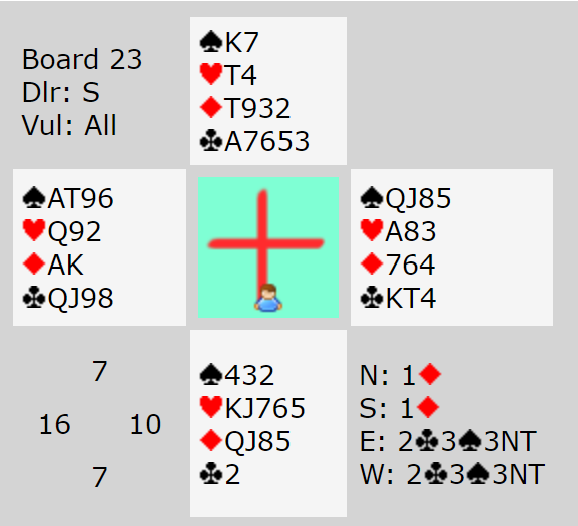Categories
Product Search
#12 - Hugh's 'Hand of the Week' - Tuesday 30 August 2022
Seven members discussed a number of interesting hands, some with a bit of a “twist”….
- #11 demonstrates a standard weak jump overcall. In the event S opens 1S, W bids 3D…with a decent 6 card suit, outside Ace and a singleton. This makes it even less likely that N/S will reach an unlikely, but makeable 4S. Some play that overcalls at the 3 level require more points (11-15), yet others make it variable (weak if non-vul, 11-15 if vul).
- #18 poses a challenge in slam bidding. In most systems, S would open 1C, N would respond 1H, and S rebid 2NT. N’s 3S now shows at least 4 spades and 5 or 6 hearts…but is forcing. 3NT would be reasonable from S, whereupon N bids 4S, showing 6-5 in hearts and spades, and points. S’s dilemma now is to choose between NT, spades and hearts. The advantage of the former is that the lead of a diamond comes around to S. Whichever slam is played, by either N or S, the contract really depends on E having the AD. One twist: some E’s, if they play a weak 2D opener, might open 2D. This makes it harder for N/S to reach slam (one way might be a 2NT overcall by S, 3D by N, transfer to hearts, 4NT ask for aces, then 6H), but it makes the play easier as E now likely has AD!
- #19 introduces some interesting bidding…playing Acol, S opens 1S, N responds 2S, and E comes in either with 2NT (minors) or 3D (much better suit, 6 cards). S bids 3S, and N bids 4S, with a singleton diamond. E may now bid 5C (“6-5…come alive”). This is converted to 5D by W, an excellent sacrifice. N/S should not bid 5S (“the 5-level is for the opposition”…and “don’t bid 5 over 5” are well-known pieces of good advice….unless you have exceptional distribution). Another twist: S opens 1S, but N likes the distributional nature of his/her hand and jumps to 4S. If he/she chooses, E can still sacrifice by bidding 4NT (“unusual”, showing minors), but now E/W will likely play in 5C, not as good as 5D. Another twist: why does 3NT fare so poorly? On a diamond lead, if E holds up twice, and W keeps leading it, E/W make 4 diamonds, AH and KC.
- #26 is a challenging hand for E to play in 3NT. At our table the bidding went 1S by E, 2H by W (slightly cheeky, better is 1NT), 3C by E, 3H by W and 3NT by E. S led a diamond (no other lead is better). E thinks (it is important to have a plan here…where will I find my extra tricks? Hearts seems the best bet, even if you lose 3 tricks in the process… but you need 3 entries to set them up. Therefore on the diamond led, E must take it with the Ace, assuming S has the Q, thus preserving 2 entries to dummy. This gives away 1 diamond trick, but gains 3 heart tricks. “Beware the cheap trick” is another common saying.
HAND OF THE WEEK - Board #23
 There are 2 scenarios in the bidding here, depending on one’s bidding system.
There are 2 scenarios in the bidding here, depending on one’s bidding system.
Playing Strong NT and 5-card majors, W opens 1NT…what should E bid? Some would automatically Stayman, looking for a spade fit, and bid 4S in due course.
Playing Acol, the bidding is more likely to go 1S – 3S – 4S.
What is the best defence? Doubleton leads go in and out of favour…here 10H from N works well.
W likely ducks, S takes KH and leads the singleton club. Partner plays AC and another, the ruff taking 4S down one. Even if declarer takes the heart lead with the Ace, and plays Ace and another S, N still gets in, plays another heart, the club comes back and S has a third spade to effect the ruff…always 1 down… despite a good 4-4 fit and 26 combined points.
What can be done? This hand favours the strong NT/5 card majors system….but E should not Stayman. This is the tip: don’t Stayman with a 4, 3, 3, 3 distribution. There is likely no ruffing power, so the hand will often be played like NT…but one level higher. In this scenario, it is quite often the case that 3NT can be made, but not 4 of a major, despite a 4-4 fit!
Click here to see the hand records for Tuesday 30 August.
